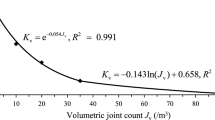Abstract
The role and importance of rock mass classification systems from past to present in engineering designs are indisputable. Therefore, the correct estimation of the parameters that make up these systems is essential in terms of reliability, time, and economy. One of the crucial parameters commonly used in rock mass classification is the rock quality designation (RQD). This study aimed to indirectly estimate the RQD value determined from the core samples obtained from the exploration drillings. In this context, P wave velocity (Vp) was obtained by seismic refraction tomography (SRT) from the geophysical measurements applied in the metamorphic rock mass, and the discontinuity frequency parameter was obtained from the line survey studies carried out on the rock mass. What determined RQD values with the help of simple regression analyzes and empirical equations with high estimation capacity using Vp and discontinuity frequency parameters were obtained without drilling in the rock mass. Accordingly, the performance indexes of the equations produced by different researchers and the equations produced in this study were evaluated in determining the RQD parameter. In the generated equations, the highest coefficient of determination value depending on joint frequency and Vp wave velocity with RQD was calculated as R2 = 0.89 and R2 = 0.82, respectively. When the produced equations are evaluated according to the performance indexes, it is seen that the empirical equations obtained by previous studies have the highest root mean square error (RMSE) and values account for (VAF) values compared to the other equations and have very high estimation capacities. Thanks to the equations with high estimation capacity, the RQD value was determined depending on the joint density and Vp speeds.








Similar content being viewed by others
References
Azimian A (2016) A new method for improving the RQD determination of rock core in borehole. Rock Mech Rock Eng 49:1559–1566
Bery AA, Saad R (2012) Correlation of seismic P-wave velocities with engineering parameters (N value and rock quality) for tropical environmental study. Int J Geosci 3(4):749e57
Budetta P, De Riso R, De Luca C (2001) Correlations between jointing and seismic velocities in highly fractured rock masses. Bull Eng Geol Environ 60(3):185e92
Deere DU (1964) Technical description of rock cores for engineering purposed. Rock Mech Rock Eng 1:17–22
El-Naqa A (1996) Assessment of geotechnical characterization of a rock mass using a seismic geophysical technique. Geotech Geol Eng 14(4):291e305
Farhadian H (2021) A new empirical chart for rockburst analysis in tunnelling: tunnel rockburst classification (TRC). Int J Min Sci Technol 31(04):603–610
Hudson JA, Priest SD (1983) Discontinuity frequency in rock masses. Int J Rock Mech Min Sci & Geomech Abstr 20:73–89
Priest SD, Hudson J (1976) Discontinuity spacing in rock. Int J Rock Mech Min Sci & Geomech Abstr 13(5):135e48
Said MJM, Zainorabidin A, Madun A (2015) Soil velocity profile on soft soil using seismic refraction. Appl Mech Mater 773–774:1549–1554
Salaamah AF, Fathani TF, Wilopo W (2018) Correlation of P-wave velocity with rock quality designation (RQD) in volcanic rocks. J Appl Geol 3(2):62–72
Salimun N, Rafek AG, Noh KAM (2019) Correlation of seismic velocity and mechanical properties of metasandstone from CTW-1 well, Seri Iskandar, Perak. Malaysia Warta Geologi 45(2):40–42
Sari M, Seren A, Alemdag S (2020) Determination of geological structures by geophysical and geotechnical techniques in Kırklartepe Dam Site (Turkey). J Appl Geophys 182:104174
Sen Z (1984) RQD models and fracture spacing. J Geotech Eng 110(2):203–216
Sen Z, Kazi A (1984) Discontinuity spacing and RQD estimates from finite length scanlines. Int J Rock Mech Min Sci & Geomech Abstr 21:203–212
Sen Z (1993) RQD-fracture frequency chart based on a Weibull distribution. Int J Rock Mech Min Sci & Geomech Abstr 30(5):555e7
Sheehan JR, Doll WE, Mandell WA (2005) An evaluation of methods and available software for seismic refraction tomography. J Environ Eng Geophys 10:21–34
Sonmez H, Ercanoglu M, Dagdelenler G (2021) A novel approach to structural anisotropy classification for jointed rock masses using theoretical rock quality designation formulation adjusted to joint spacing. J Rock Mech Geotech Eng. https://doi.org/10.1016/j.jrmge.2021.08.009
Vali B, Arpa G (2013) Finding the relationship between RQD and fracture frequency in the different Ok tedilithologies. Procedia Earth and Planetary Science 6:403–410
Wines DR, Lilly PA (2002) Measurement and analysis of rock mass discontinuity spacing and frequency in part of the Fimiston Open Pit operation in Kalgoorlie. Western Australia: a Case Study. Int J Rock Mech Min Sci & Geomech Abstr 39:589–602
Zhang L (2016) Determination and applications of rock quality designation (RQD). J Rock Mech Geotech Eng 8:389–397
Zheng J, Yang X, Lü Q, Zhao Y, Deng J, Ding Z (2018) A New Perspective for the Directivity of Rock Quality Designation (RQD) 240:81–94
Zheng J, Wang X, Lü Q, Liu J, Guo J, Liu T, Deng J (2020) A contribution to relationship between volumetric joint count (Jv) and rock quality designation (RQD) in three-dimensional (3-D) space. Rock Mech Rock Eng 53(3):1485–1494
Acknowledgements
We thank the Gumushane University for supporting our project. We would like to thank Güven Köksal KUTLU, 22nd Regional Directorate of State Hydraulic Works, Groundwater Branch Manager, who allowed the use of additional drilling data at the dam site.
Funding
This work was supported by the Scientific Research Projects Foundation of Gumushane University (Project No: 18.F5114.02.01).
Author information
Authors and Affiliations
Corresponding author
Ethics declarations
Conflict of interest
The authors declare no competing interests.
Rights and permissions
About this article
Cite this article
Alemdag, S., Sari, M. & Seren, A. Determination of rock quality designation (RQD) in metamorphic rocks: a case study (Bayburt-Kırklartepe Dam). Bull Eng Geol Environ 81, 214 (2022). https://doi.org/10.1007/s10064-022-02675-2
Received:
Accepted:
Published:
DOI: https://doi.org/10.1007/s10064-022-02675-2




